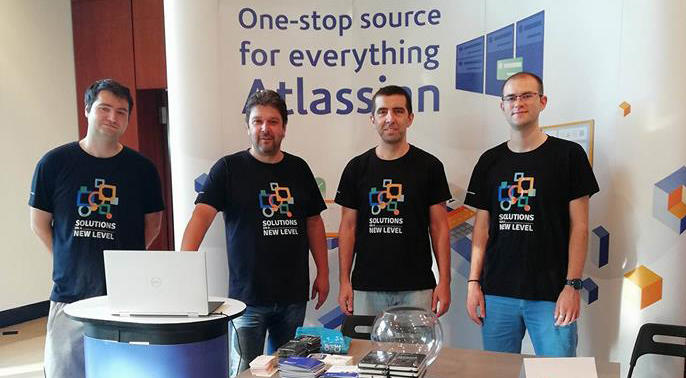

Stay Tuned
You want to find the right answers, fast.


You want to find the right answers, fast.

On 10 and 11 June we joined the DEVit 2018 fun in Thessaloniki, Greece. Nemetschek Bulgaria took part in (and sponsored) the leading 360 developer conference in South East Europe with its Atlassian team of experts. And it was ace! What is amazing about it is the fact that it’s a non-profit conference organized by volunteers and they did a great job.
We were so eager to get there and meet all these cool people that the whole crew showed up around 8am at the Royal Theater (the venue of the event). And guess what – we were the first ones there. The time we had was enough to register, set up our booth and prepare the swag.
An hour later, sleep-deprived but excited, we had everything ready and the attendees started showing up. We could feel that everyone was thrilled and prepared to learn new things, ask tough questions and network around. People were curious to find out what the sponsor companies do so they swarmed in and visited every single booth. Devs, ITs, designers, QAs…(and even high-level managers eager to expand their business) from all over the world, with different background and experience stopped by and talked to us. It was great that people were already familiar with the Atlassian products so we had productive conversations and in-depth discussions.
Knowing that people expect some souvenirs to take home with them, we’d prepared not only cool swag but also created fun atmosphere with our game. Who could resist our calling?
The DEVit STAFF made the whole experience very enjoyable. They even had a dedicated reporter who took interviews during the whole event and we can’t wait to see the “DEVit 2018 Moments” video once they upload it on their youtube channel. One of our team mates became a star so next time you see him, ask for an autograph.
The best part of the conference was the lectures. There was a surprise – we had a speaker who played the guitar on the stage. Amazing experience! We definitely learned some new tips and tricks from the talks. And because we are not greedy and believe that sharing experience with others is like a next level collaboration, here are 5 hot take-aways from a day full of lectures:
David Platt (President of Rolling Thunder Computing, Inc., instructor in Computer Science for the Harvard University Extension School) talked about the problems of software products in general in his lecture Why Software STILL Sucks. He explained the importance of knowing the users and what they want from a software. This is something we all think we know but it bears repeating: always make sure your software tends to users’ needs instead of just providing “cool” looks and complex functionalities. The most common demand is “I just want it to work”, therefore, make sure you are doing exactly that – “Making it work”. David also gave some tips on how to improve our software:
David has a whole book in which he talks in depth about all these and more. You can find it in Amazon
Pawel Dudek (iOS developer and team lead @ Toptal) talked about Behavior Driven Development (BDD) and how it helped you maintain a good software architecture. He also explained how BDD aims to improve certain aspects of TDD (Test Driven Development). Pawel shared a couple of his ideas and good practices of testing.
You can find Pawel’s slides from his lecture here
Cheryl Platz (Principal designer @ Microsoft) shared her ideas about “opti-pessimistic” product design. According to her, there’re three techniques you can apply to your product design process in order to consider the best and the worst of what your product has to offer:
We highly recommend you to check Cheryl’s slides here
Amit Zur (Frontend consultant, developer & designer @ Happy Code) showed us how he implemented the Borland Turbo-C editor using the concept of Atomic design with the help of React, MobX and Node.js. The atomic design consist of three types of elements:
Pretty cool when you look at things from this perspective! You can find Amit’s slides here
Julien Simon (AI & Machine Learning Evangelist @ AWS) unleashed the power of the AI in his lecutre AI for developers. He used his robot Johnny Pi designed with a Raspberry Pi to demonstrate different capabilities of the Amazon Web Services Machine Learning. The little fellow could understand simple commands like “turn left/right” and do complex tasks like image recognition and hand-written text translations. That was adorable and at the same time, brain-racking what we can achieve with the help of AI and how it can change the course of software development. Just imagine…
No joke here! The first night was rough because of the raging mosquitoes. They were quite active during the evening when we decided to explore the city. If you plan to visit the conference next year (like we do), make sure you’ve loaded some lifesaving sprays and ask your hotel to give you an electric mosquito repellent, too.
Let’s admit it, DEVit was a great conference! We’ve talked to extraordinary and talented people. The lectures were both entertaining and useful so a big THANK YOU to the DEVit staff and speakers. And of course, to all attendees who came and stopped by our booth. What really made us happy was that we’d met people who knew the value of Atlassian expertise and were interested in our services.
We can’t wait to come back next year sooo… see you all then!